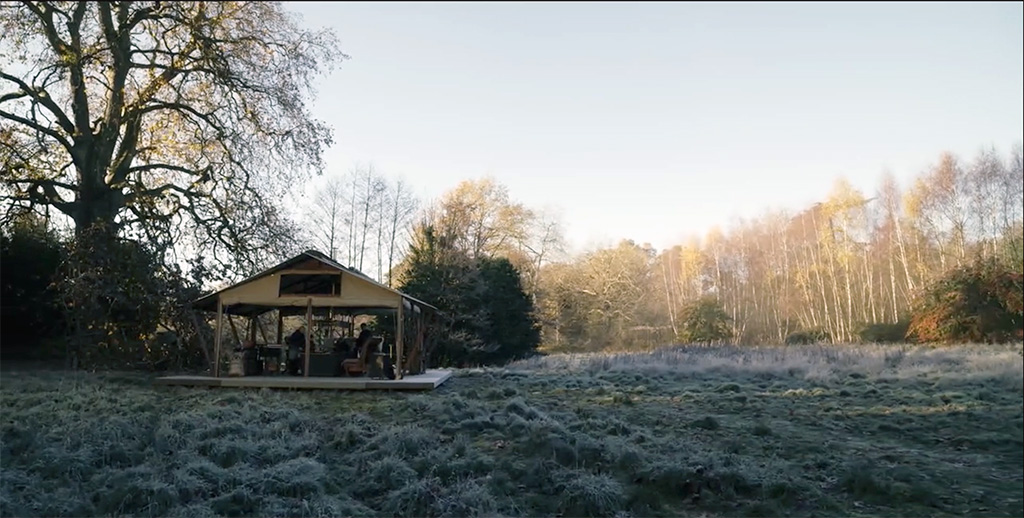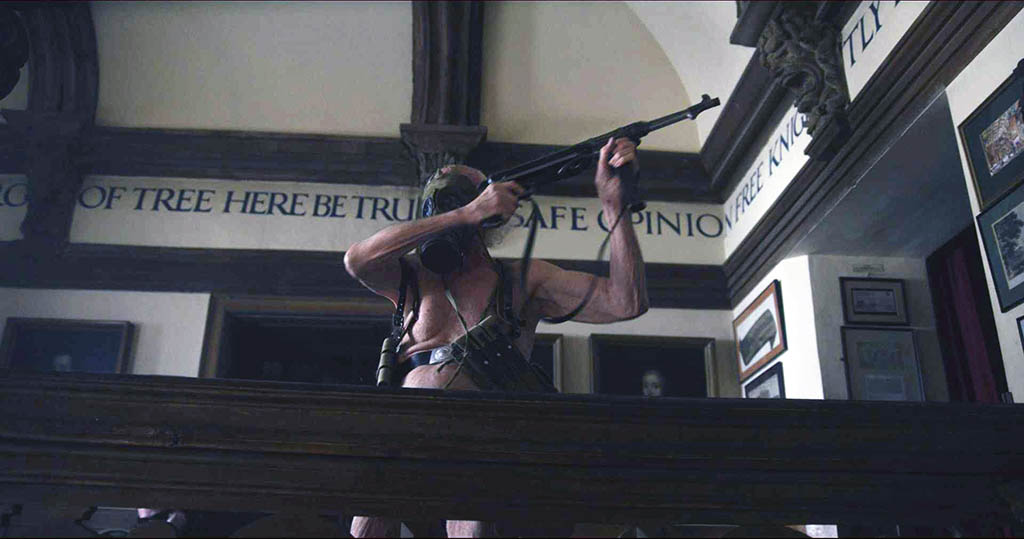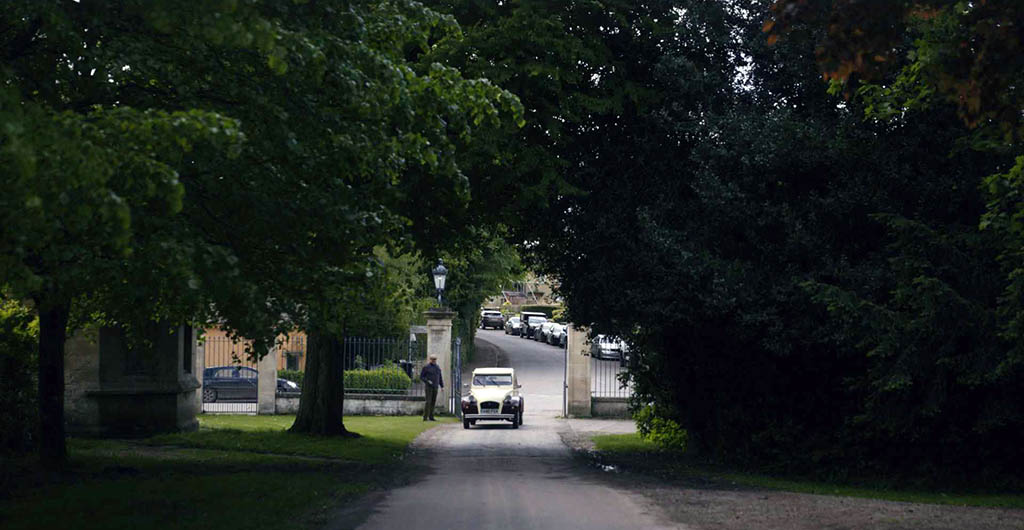By OLIVER WEBB
By OLIVER WEBB
Images courtesy of Netflix.
Guy Ritchie’s The Gentlemen is a spin-off of Ritchie’s 2019 film of the same name. The series follows Eddie Horniman, the 13th Duke of Halstead (Theo James), as he inherits his family estate and discovers a huge weed empire hidden beneath the property run by Susie Glass (Kaya Scodelario). After realizing that Susie has no intention of leaving, Eddie must navigate unfamiliar territory.

Aristocrat Eddie Horniman (Theo James) inherits the family estate and discovers that it’s home to a huge weed empire, and its proprietors aren’t going anywhere. A wide variety of VFX shots was needed to keep the story moving and add scale. From left: Liran Nathan, Theo James, Kaya Scodelario and Kristofer Hivju.
James Jordan served as Visual Effects Producer and Supervisor on the show. “There wasn’t a huge amount of VFX on The Gentlemen, but it still needs to be managed well creatively, schedule-wise and quality wise,” Jordan states. “Moonage, Guy Ritchie and Netflix had a high level of expectation for the show. Additionally, we wanted to ensure that the VFX for the show met the creative needs and moved forward from the original film.” A style guide already existed for the show due to the legacy of the film. “It wasn’t so much the look,” Jordan explains. “We had lots of meetings about the style in which Guy likes to shoot and how he likes to depict his action sequences and his blood or gunshots. Also, what the cannabis farm needed to evoke and look like. We needed to add scale from a VFX point of view and other details to enhance the creative.”

Mob boss Kaya Scodelario (Susie Glass) is running her father’s cannabis empire while he’s in prison. Director Guy Ritchie is a storyteller for whom VFX is primarily a tool to enhance aspects that can’t be shot practically.

Daniel Ings (Freddy Horniman), Eddie’s unreliable brother, patrols the estate while under the influence of cocaine, which is why he’s acting here like a manic guard-chicken. (Photo: Christopher Rafael)
“Guy doesn’t really like to do anything that doesn’t drive the story. He’s 100% story-orientated. He doesn’t want the VFX to be the story. It’s there as a tool to enhance aspects that can’t be shot for real. Some of that has to do with scale while other things have to do with the visible VFX that we already have, such as gunshots, wounds and set extensions. We have a lot of set extensions on the houses and weather fixes. It’s quite a variety of shots that they needed, but it’s there really to keep the story going and add scale to the story.”
—James Jordan, Visual Effects Producer/Supervisor

Visual Effects Producer/Supervisor James Jordan and his team created mostly invisible VFX. Splitting the shots between multiple vendors allowed different teams to work in parallel and turn around the episodes efficiently without compromising quality. From left: Joely Richardson, Theo James and Daniel Ings.
Jordan was already familiar with Ritchie’s work before coming onboard the project. “I really like his storytelling,” Jordan says. “I’ve watched most of his films, but The Gentlemen obviously felt the most relevant in terms of references as the show is a spin-off of the film. Guy doesn’t really like to do anything that doesn’t drive the story. He’s 100% story-orientated. He doesn’t want the VFX to be the story. It’s there as a tool to enhance aspects that can’t be shot for real. Some of that has to do with scale while other things have to do with the visible VFX that we already have, such as gunshots, wounds and set extensions. We have a lot of set extensions on the houses and weather fixes. It’s quite a variety of shots that they needed, but it’s there really to keep the story going and add scale to the story.”

Lead creative vendor Jellyfish Pictures was primarily responsible for the weed farm extensions.
When it came to managing the VFX workload with his team, Jordan went through the scripts in advance, breaking down the arc of the stories and finding out what the balance of shots were going to be. “That informed how we would create some of the assets that needed to be repeated,” Jordan notes. “For example, for the weed farm extension, the set was one container deep, so every time you see the weed farm looking through it, it all had to be a 3D build, and so that is a 3D set extension. The way we built that was determined by how many times we knew we were going to be seeing it. The more you are going to see it, the more you want to make sure that you’ve got enough detail and it’s a 3D asset that you can see from any angle. So, we worked out what the types of shots we would need. There is also a graphic element in terms of the episode title, and Guy had a very specific idea of how he wanted the text to come across. There were other graphic elements that needed to have a certain energy to them, and even though they were digitally created, the series style required them to feel organic and more filmic, like an old-style film title rather than a digital film title. So, we very much wanted it to be a lot more set into the footage, rather than having a clean graphic. So, those were some of the discussions we were having creatively about how he wanted things to look and fit.”

Because the weed farm set was only one container deep, every time the weed farm was seen and looked through, a 3D build and 3D set extension was needed with enough detail that it could be viewed from any angle.
“[F]or the weed farm extension, the set was one container deep, so every time you see the weed farm looking through it, it all had to be a 3D build, and so that is a 3D set extension. The way we built that was determined by how many times we knew we were going to be seeing it. The more you are going to see it, the more you want to make sure that you’ve got enough detail and it’s a 3D asset that you can see from any angle.”
—James Jordan, Visual Effects Producer/Supervisor

Visual Effects Producer/Supervisor James Jordan and his team shot a motion control animation sequence to create a time-lapse sequence as part of documenting a cannabis plant’s journey from seed to street.
Jordan worked alongside VFX Editor Celine Glasman James and VFX Production Manager Irene Garcia Alonso. “We had the three of us on the VFX production team, but we spilt our work between five vendors because we knew we had quite a quick turnaround on each episode from a delivery point of view,” Jordan says. “We broke the show down so that we had vendors doing particular tasks. Our lead creative vendor, Jellyfish Pictures, was doing the weed farm extensions primarily and some of the enhancements. For example, the dart in the head we had to put into 3D as it was it was difficult to shoot with a prop. We also had Peerless, who did some of the matte paintings. For set extensions, we had a couple of mid-level vendors who were doing such things as replacements and graphic type elements, and then a fifth company that was specializing primarily in clean-up. On average, we had about 70 to 80 shots per episode, with one episode consisting of 150 shots, so it was not a heavy VFX show. Splitting the shots between multiple vendors meant we could work in parallel and turn around the episodes very efficiently without compromising quality.”
“The most complicated challenge that we had was time, in terms of how quickly we were turning the episodes around. From starting the VFX on any particular episode to delivering the finals, we had on average four or five weeks. That’s a really quick turnaround, particularly if you want to maintain a high quality, which was a must for us. The show is very polished, and the VFX had to meet the quality and the expectation of Guy, Moonage and Netflix…”
—James Jordan, Visual Effects Producer/Supervisor

Building the 3D environments for the weed farm extensions involved work across all the episodes, and had to service all angles and lighting conditions. Above: Daniel Ings as Freddy.
The most complicated aspect of the visual effects for Jordan and his team was building the 3D environment for the weed farm extensions. “That involved work across all the episodes, and it had to service all the different angles and lighting conditions. That was probably our biggest asset for the season. We also shot a motion control animation sequence to create a time-lapse sequence as part of a cannabis plant’s journey from seed to street.”


Due to changes in the weather, weather corrections were needed. Fixes were added in post to make the sequences consistent with frost and snowfall.
“Most of the shots were relatively straightforward,” Jordan continues. “In this type of show there are things like muzzle flashes and blood on face and weapons in close proximity to people where we added all the lighting and the muzzle flashes and blood interaction. I wouldn’t say any of those are particularly complicated, but they do need to look and feel right. The most complicated challenge that we had was time, in terms of how quickly we were turning the episodes around. From starting the VFX on any particular episode to delivering the finals, we had on average four or five weeks. That’s a really quick turnaround, particularly if you want to maintain a high quality, which was a must for us. The show is very polished, and the VFX had to meet the quality and the expectation of Guy, Moonage and Netflix while ensuring that everything was done on schedule and within budget, but still meeting the creative needs.”


Muzzle flashes and blood were added in post. Most of the visible VFX in the show consisted of gunshots, wounds and set extensions.


Invisible VFX included bluescreens, replacements and clean-up, such as removing vehicles parked along the road leading to the manor to make it look like an isolated country estate.
“When you have block directors, it’s also interesting to see how they then take the framework of the lead director and add their own creativity for their episodes. Each director did two episodes, and Guy did Episodes 1 and 2. It was a truly collaborative team. … It all felt very supported, and even though there were busy days and lots of changes, it always felt like there was an understanding of what the challenge was and an appreciation of the efforts that were undertaken to make everything work.”
—James Jordan, Visual Effects Producer/Supervisor

Half of the outdoor prison sequence was shot with real snow and half without, because it was shot during a period when there was a cold spell with only a few days of snow.
Jordan and his team relied on creating mostly invisible visual effects shots. “It’s not about the VFX in this show. In this instance, if you are seeing the VFX as obvious then we haven’t really done a good job,” Jordan notes. “There’s lots of weather corrections throughout, such as the sequence with the snow when the travelers arrive. Half of that was shot with real snow and half without because it was shot during a period when we had a cold spell and a few days of snow, which affected the arrival of the travelers at the house and also the prison scene with Ray Winstone where he was talking to Suzie and Eddie for the first time. Half of that was shot when it was foggy and the other half wasn’t, so we had to weather correct all those shots so it all fits together well. They are quite tricky things to get right, but they are not things that you make a fuss about, yet it all flows and is not questioned. The challenge for ]VFX] is to not stand out in any way, so you don’t notice it, which is much the same for some of the other visual effects that we had. Sometimes we were shooting day sequences or looking through windows at night, and they used bluescreen. For some of the shots, you are looking at the background in-camera; other [backgrounds] have been added digitally. If you notice the difference then we haven’t done our jobs well enough. There really isn’t such a thing anymore as a non-VFX show. Anything less than 120 or 150 shots per episode I would regard as low, but there are always lots of things that are needed. Every type of show you see now has VFX embedded.”

Director Guy Ritchie and actor Vinnie Jones on the set of The Gentlemen. (Photo: Christopher Rafael)
Jordan concludes, “It was an absolutely fantastic crew. I really enjoyed working with the three directors, David Caffrey, Eran Creevy and Nima Nourizadeh. They all had different approaches, which was great. Guy has his method, and having watched and enjoyed his films, I was intrigued to see how he pieces it all together. It’s great to see how a successful director runs his creative part of the set; I enjoyed seeing that. When you have block directors, it’s also interesting to see how they then take the framework of the lead director and add their own creativity for their episodes. Each director did two episodes, and Guy did Episodes 1 and 2. It was a truly collaborative team. Moonage is a fantastic production company. It all felt very supported, and even though there were busy days and lots of changes, it always felt like there was an understanding of what the challenge was and an appreciation of the efforts that were undertaken to make everything work. It’s one of the shows I’ve enjoyed working on the most, primarily for that reason. It never felt stressful, even though it was difficult at times.”